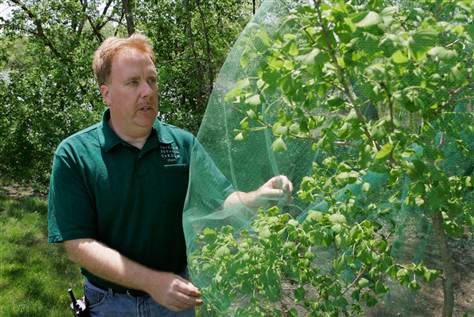
The only way Herb can tolerate the noise of the Cicadas is to pretend to conduct them. Luckily this happens only every 13 years!
The world’s largest living insect is the cicada and it stay underground for thirteen or seventeen years before it comes out to mate. Every seventeen years in Northern Virginia, we experience one of nature’s most unusual phenomena.
The seventeen year brood is a large one and it announces its presence quite loudly. The male cicada makes quite a racket to attract a mate. In fact, the noise from the cicadas can exceed an ear piercing 120 dB. That’s louder than a jet aircraft or a jackhammer.
If you would like to know the full story about cicadas, the Virginia Cooperative Extension Service has an excellent on-line publication. Click here to read more.
Cicadas are relatively harmless to people, plants and trees. They do not bite or sting. They also do not feed on tree leaves or roots.
Cicadas can damage small twigs and branches because the female will deposit her eggs inside small branches the size of a pencil. The twigs die when the female bores under the twig bark to place her eggs. The dead twig’s color contrasts with the green leaves. This is called “flagging”. Young trees are the most severely damaged by flagging because they have more branches of the preferred size for egg laying by the cicada.
Although Oaks are commonly attacked, the most serious damage occurs on newly planted ornamental, deciduous trees. Pines and evergreens are not usually attacked.
Here is a list of commonly affected trees:

Tom Tiddens, an arborist at the Chicago Botanic Garden, stands next to a small tree covered with tulle. Tiddens recommends covering small or young trees with netting to protect them from damage caused by egg-laying cicadas.
(AP Photo/Charles Rex Arbogast)
Pesticides and insecticides are relative ineffective in controlling cicadas and they can negatively impact helpful pollinating insects. Large established trees can show signs of flagging but rarely suffer long-term damage. Young, newly planted trees can be protected by covering with fine mesh netting.
When netting trees it is important not to pull the netting too tight. Loosely cover the entire tree canopy allowing the branches to hang naturally.
The most important part of netting a tree to prevent cicada damage is to securely fasten the netting around the trunk of the tree. Mating cicadas do not have wings and do not fly onto tree branches. They crawl up the trunk to the branches where the female deposits her eggs. Securely fastening the netting around the tree trunk is extremely important to prevent mating cicadas from crawling up into the netted tree.
Install the tree netting in May and remove the tree netting at the end of June. Mature, mating cicadas only live two to four weeks. The eggs deposited in the small tree branches take six to ten weeks to hatch. The larva do not feed on the tree branches or leaves. When the larva hatch they drop to the ground, around the base of the tree and burrow into the ground. The larva feed on the sap from the tree roots but not on the roots themselves.
Industrial Netting manufactures a Cicada Control Netting product. You can purchase this on-line by clicking here.
Here is a video from NBC with some additional information.
Visit NBCNews.com for breaking news, world news, and news about the economy